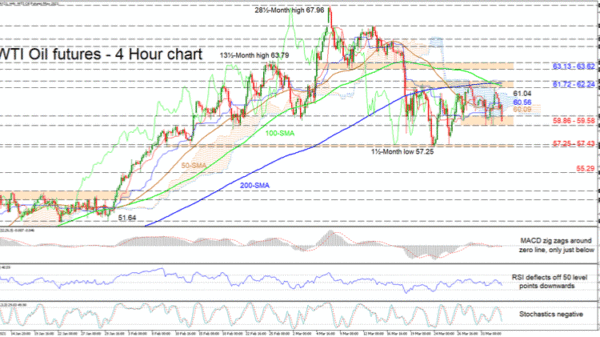WTI oil futures are currently tackling the direct support zone of 58.86-59.58 on the four-hour chart, although remain within a ranging market between the confines of 57.25 and 62.24. The 50-period simple moving average’s (SMA) bearish incline has waned slightly and is promoting the sideways market, while the falling 100-period SMA, which has recently completed a bearish crossover of the 200-period SMA, is feeding the negative picture.
The Ichimoku lines are demonstrating a lack of directional impetus, backing the neutral price pattern, while the short-term oscillators are signalling a slight pickup in negative sentiment. The MACD has slipped marginally below zero and its red trigger line, while the RSI is falling in bearish territory after a deflection off the 50 level. The stochastic oscillator is retaining a negative charge and is suggesting additional deterioration in the price.
If sellers successfully manage to steer the price beneath the 58.86-59.58 region of support, the bears may then dive for the foundation of the recent trading range, which coincides with the troughs from back in early February. Should this floor fail to dismiss a more dedicated retracement in the commodity, the price could plunge towards the next probable support target located at 55.29.
If buyers re-emerge and drive the price higher, initial upside friction could arise in the zone from the 50-period SMA at 60.09 until the blue Kijun-sen line at 60.56. From here, should the price climb above the cloud, buyers could then meet the key resistance section of 61.72-62.24, which also contains the 100- and 200-period SMAs. However, if buyers propel beyond this heavy roof, another border limiting the upside trajectory could appear around 63.13-63.62.
Summarizing, WTI futures will need to break below 57.25 or above 62.24 to reveal the next clear price direction.














